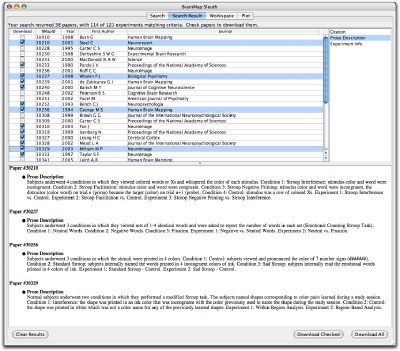Sleuth Version 3.0.4
Announcement
June 8, 2020: A new version of Sleuth is out! It fixes the problem that we had last week, communicating with one of our servers. Sorry for the extended down time!
Sleuth is the BrainMap application that is used to search for papers of interest, read their corresponding meta-data, and plot their results as coordinates on a standard glass brain in Talairach space.

Sleuth is broken into four main panels: Search, Results, Workspace, and Plot.
Search Panel
To perform a search of the BrainMap database, first choose which database you would like to search, task or voxel-based morphometry. The graphical user interface of Sleuth has been redesigned, and now allows users to build searches with multiple criteria using an interface that was inspired by the playlist building feature in Apple’s iTunes software. You may select your desired search criteria from the main interface: "Citation", "Subjects", "Conditions", "Experiments", "Locations" for the task database, and "Citation", "Subjects", "Conditions", "Analysis", "Locations" for the VBM database. When you have finished making your search selections, hit "Search".

Results Panel
Once your search has been completed, a list of all papers matching your criteria is available for preview in the Results panel. This panel is intended to screen searches by showing limited information on each paper. To download the papers of interest into your workspace, choose "Download Checked" or "Download All".

Workspace Panel
In this panel, you will find complete information on each paper and each experiment. The workspace contents and vital statistics are shown in the top portion of the panel. On the right, you can choose what information you wish to view about each experiment, including Citation, Submitter, Prose Description, Subjects, Conditions, Brain Template, Experiments, and Results Synopsis. This information is viewed in the bottom panel.

Plot Panel
In the next panel you can view a plot of all the coordinates in your workspace, color-coded by paper. By default, the orientation is on axial, but can be changed to coronal or sagittal using the appropriate button on the bottom left. The middle bars allow you to scroll through different slices in the brain.

Video Overview
A quick, five minute overview, showing the basics of using Sleuth:
Database Taxonomy
More information about the data that is searchable in Sleuth, and shown in the results and workspace, is available for reference in our Taxonomy page.